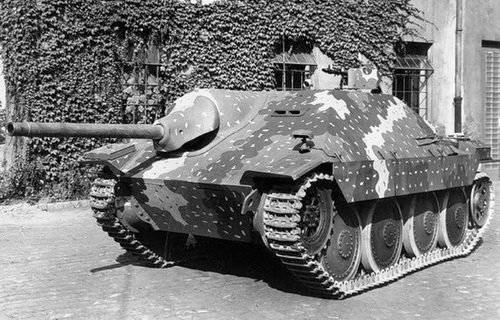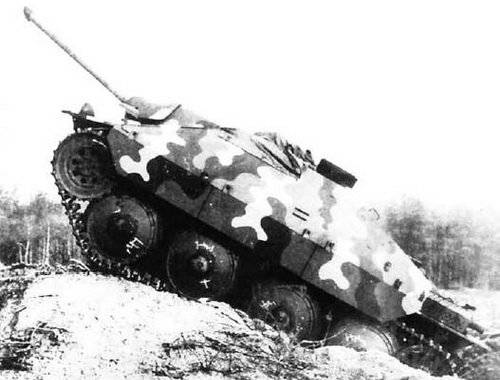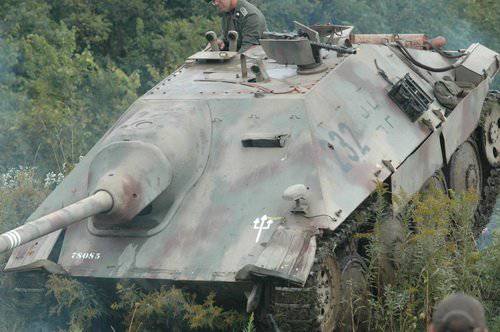Anti-tank SAU of Germany during the war (part 4) - Hetzer
Combat practice dictated to the Germans the need to develop a single anti-tank machine instead of the accumulated various self-propelled guns with an infinite number of modifications. A variety of self-propelled fleet fleet increasingly left the Germans sideways: there was confusion in the tactical use of a variety of machines, which was aggravated by constant difficulties with the supply of spare parts and training of tank crews. There was a need to unify existing ACS.
The first such idea in March 1943 was put forward by Heinz Guderian. After that, the Panzerjager program was launched for implementation. The new tank destroyer was supposed to be as simple as possible in production, cheap, mobile, efficient and suitable for mass production. At this time, Germany's tank building did not cope with the release of armored vehicles for the needs of the Wehrmacht. That is why, in order not to reduce the pace of production of German tanks, it was decided to produce self-propelled guns on the basis of a light Czech tank PzKpfw 38 (t). For the standard of manufacturability was adopted medium tank "Panther". For the same man-hours that were needed to build the Panthers 1, it was necessary to assemble the 3 new machines that had comparable firepower.

The bold idea of creating a fairly powerful tank destroyer based on the Pzkpfw 38 (t) tank did not cause much enthusiasm among the developers. Perhaps this idea would continue to gather dust on the shelves if it had not intervened aviation allies. On November 26, the Allied Aviation dropped 1 tons of bombs on Berlin. This airstrike seriously damaged the shop of the company Alket, which was engaged in the production of assault guns. Along with this, the air raid dusted off the draft of the new self-propelled guns, and the German command began to search for alternative production capacities that could make up for the shaky issue of StuG III. On December 424, 6, the OKN reported to Hitler that the Czech VMM enterprise would not be able to produce the 1943-ton StuG, but was able to overpower the production of a light tank destroyer.
New SAU was created with amazing speed. Already 17 December 1943, Hitler was shown the drawings, which he approved. Against the backdrop of the flourishing of giantomania in German tank building, the Fuhrer would have preferred a heavier machine, but he had no choice.
January 24 The 1944 of the year was made a wooden mock-up of ACS, and on January 26 it was demonstrated to the Armed Forces Division of the Ground Forces. The military liked the project, and by March 3 vehicles were to be produced in metal for military tests. 28 January 1944 of the Year Hitler pointed out the importance of launching the SAU Hetzer series as the most important machine for the Wehrmacht in the 1944 year.
Hetzer was ready for release in less than four months. A series of pre-series tests of the machine was simply ignored, since on the one hand the creators were pressing for time, on the other the self-propelled gun base - the Pzkpfw 38 (t) tank was already well known to the military. By 18 January 1944, it was determined that by March 1945, the production of ACS should reach 1000 units per month. By German standards, these were very impressive figures, 2 enterprises should have been responsible for the release of the Hettzers: BMM and Skoda.

Description of construction
The new tank destroyer had a low hull with rational slopes of frontal and upper side armor plates. The machine received an 75-mm gun with a barrel length 48 calibers. The gun was covered with cast armor known as the “pig's snout”. On the roof of the hull was located 7,92-mm machine gun, having a shield cover. The engine was located in the rear of the car, the drive wheels and the transmission were in the front. Chassis consisted of 4 rollers. Part of the machines was made in the form of self-propelled flamethrowers, in this case the flamethrower was installed instead of the gun. In total, from 1944 of the year to the end of the war, approximately 2 600 SAU Hetzer were manufactured, which were used in anti-tank battalions of Wehrmacht motorized and infantry divisions.
In the ACS, many fundamentally new technical and design solutions were implemented, although the designers tried to achieve maximum unification with the Marder III light tank destroyer and the Prague tank. The case of armor plates of a sufficiently large thickness was made by welding, and not by bolts. This technology was used in Czechoslovakia for the first time.
The welded body of the Hetzer, except for the roof of the engine and combat compartments, was sealed and monolithic. After mastering the welding work, the labor intensity of its manufacture in comparison with the riveted method was reduced almost 2 times. The nose of the self-propelled gun consisted of 2-x armor plates with a thickness of 60 mm., Which were installed at large angles of inclination - 40 degrees lower and 60 degrees upper. The Hetzer had an 20 mm reservation. and were also installed at sufficiently large tilt angles, well protecting the crew from large fragments, anti-tank rifles and small-caliber artillery bullets (up to 45-mm).
The layout of Hetzer was new, for the first time the driver was located to the left of the longitudinal axis (before the war in Czechoslovakia, a right-side landing was taken in the tank). Behind the driver, to the left of the gun were the gunner and loader, the place of the installation commander was to the right behind the cannon fence.

For landing and exit of the crew was provided 2 hatch. In this case, the left one was intended for landing / disembarking the loader, the gunner and the driver, and the right one was intended for the commander. In order to reduce the cost of construction, serial ACSs were initially equipped with a very small set of surveillance tools. Two periscopes (often only one was put) had an SAU driver for reviewing the road, the gunner could follow the terrain only with the help of a periscope sight “Sfl. Zfla "with a small field of view. Charger could follow the terrain only with the help of a defensive machine gun sight, which had the ability to rotate around a vertical axis.
The commander of the ACS, having opened the hatch, could use a remote periscope or stereo tube to observe. In the event that the hatches of the car were closed, the crew could not inspect the surroundings from the starboard and stern, they could only be observed with a machine gun sight.
The 75-mm PAK39 / 2 anti-tank cannon with a barrel length 48 of calibers was mounted in a narrow embrasure of the frontal hull sheet just to the right of the longitudinal axis of the SAU. The right-left angle of the gun was not the same (11 degrees to the right and 5 degrees to the left). This was due to the large breech of the gun at the small size of the fighting compartment, as well as the asymmetry of the gun. It was possible for the first time to fit such a large weapon into such a modest fighting compartment. stories Czechoslovak and German tank building. This was achieved through the use of a special cardan frame, which was used instead of the traditional machine gun.
Hetzer was equipped with the Praga AE engine, which was a further development of the Swedish engine Scania-Vabis 1664, which was produced in Czechoslovakia under license. The engine consisted of 6 cylinders, was unpretentious and had good performance characteristics. This modification of the engine had a 2 th carburetor, with which it was possible to raise the speed from 2100 to 2500, and the power from 130 to 160 hp (later it was possible to force it to 176 hp). On a highway and good ground, a tank destroyer could reach speeds of up to 40 km / h. The capacity of two fuel tanks was 320 liters, these fuel reserves were enough to overcome 185-195 km.

Initially, the ACS chassis contained elements of the PzKpfw 38 (t) tank using reinforced springs, but with the start of mass production, the diameter of the road wheels was raised from 775 to 810-mm. To increase the maneuverability, the track of the tank destroyer was increased from 2140 mm. to 2630 mm.
Combat application
In Germany, it was too late to understand that to fight allied tanks they needed not “all-destroying” capricious and expensive monsters in production, but small and reliable PT-ACS. The tank destroyer Hetzer has become a masterpiece of German tank building. Unobtrusive, and most importantly, a cheap car in production, managed to inflict significant damage to armored units of the Red Army and allies.
The first Hetzers began to enter combat units in July 1944. The vehicles were distributed to battalions of tank destroyers. Statewide, each battalion was to consist of 45 PT-ACS. The battalion consisted of 3 mouth for 14 machines, another 3 SAU was located at the location of the battalion headquarters. In addition to the separately created battalions, the Hetzers entered service with the anti-tank divisions of infantry divisions and units of the SS troops. From the beginning of 1945, even individual anti-tank companies armed with these self-propelled guns began to form in Germany. Separate Khetzerov platoons were part of various improvised connections, which were created from Volkssturm and sailors. Often the Hetzers replaced the missing Tigers in separate battalions of heavy tanks.
PT-SAU Hetzer was actively used during the battles for East Prussia and in Pomerania and Silesia, they were also used by the Germans during the Arden offensive. Due to the rational angles of armor, very low silhouette, which was borrowed from the Soviet SAU, this small tank destroyer perfectly fulfilled its role, acting from ambushes and quickly changing position after the attack. At the same time, his gun was inferior to the guns of the Soviet tanks EC-2 and T-34-85, which excluded duels with them at long distances. Hetzer was an ideal self-propelled gun, but only in close combat, attacking from ambush.

At the same time the tankers themselves noted a number of serious shortcomings of the machine. Former Commander Hetzer Armin Zons does not consider Hetzer to be an outstanding tank destroyer of the past war. According to him, the main advantage of the ACS was that with its appearance the Wehrmacht infantry units began to feel more confident. A good gun and the entire construction of the self-propelled gun spoiled its location. The gun had the most minimal angles of horizontal guidance (16 degrees) among all German self-propelled guns. This was one of the main drawbacks of the car. The displacement of the gun to the right led to unsuccessful crew accommodation. The commander of the ACS sat alone, which also had a negative impact on the crew’s interaction during the battle. In addition, the commander’s review of the battlefield was very limited, and the smoke of the gun shots located directly in front of him worsened the review even more.
5 degrees for pointing the gun to the left was obviously not enough, and the driver-mechanic often had to turn the PT-ACS, substituting the weakly protected 20-mm board to the enemy. Hetzer’s on-board armor was the weakest among all German tank destroyers. At the same time, any turn of the gun to the right pushed the loader away from the main source of projectiles, which was on the wall opposite the loader below the gun.
Despite the shortcomings, Hetzer was actively used on all fronts of the Second World War. On 10 on April 1945 of the year in the combat units of the SS and Wehrmacht were 915 PT-SAU Hetzer, of which on the Eastern Front 726, on the Western Front 101. Also, on the basis of the Hetzer, 30 ACS were produced with 150-mm infantry guns sIG.33, 20 flamethrower tanks and 170 BREM.
Hetzer performance characteristics:
Mass: 16 t.
Dimensions:
Length 6,38 m., Width 2,63 m., Height 2,17 m.
Crew: 4 people.
Reservations: from 8 to 60 mm.
Armament: 75-mm gun StuK 39 L / 48, 7,92-mm MG-34 or MG-42 machine gun
Ammunition: 41 projectile, 1200 ammunition.
Engine: 6-cylinder carburetled liquid-cooled engine Praga AE, hp power 160
Maximum speed: on the highway - 40 km / h
Power reserve: 180 km.
Information